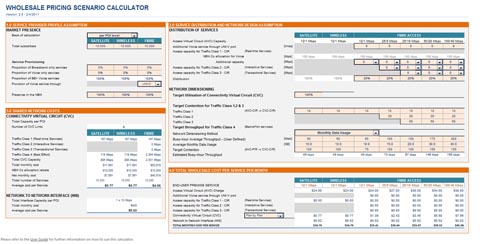The National Broadband Network Company has released an online calculator that allows users to calculate projected wholesale costs for providing services on its planned network, as debate continues to swirl about whether its pricing model will disadvantage smaller ISPs who want to play on the national stage.
The company has been engaged in a public discussion now for several weeks regarding its pricing with telco industry stalwarts such as Internode managing director Simon Hackett and NEXTDC chief executive Bevan Slattery. Late last week NBN Co used a post on the forums of broadband information site Whirlpool to provide a great deal of detail about the mechanics of its pricing model.
It emerged through another user’s post this after that the company had also published what it has dubbed its ‘Wholesale Pricing Calculator’.
The site states that the calculator is intended to provide service providers with an indicative guide to recurring wholesale costs on its network, based on NBN Co’s product and pricing overview released as part of its corporate plan in December 2010. It features a large number of customisable fields, ranging from the make-up of a service provider’s customer base, to costs associated with various aspects of NBN Co’s wholesale service — such as the ‘Connectivity Virtual Circuit’ and ‘Access Virtual Circuit’ components which ISPs will need to buy.
Contention ratios are also included in the calculation (how many users share the same bandwidth) and the calculator even sets a target for utilisation of connections.
However, despite the level of detail which has been built into the calculator, NBN Co’s site states that it should be used “as a guideline only”. “NBN Co does not intend for this calculator to be relied upon for any technical or commercial assessment or decision,” the company said. “Please contact your account manager for advice on NBN Co’s solution to your specific requirements.”
In addition, the terms and conditions for use of the calculator state that it is limited to monthly recurring costs — not covering any establishment costs, for example, or “enhanced service level agreements”. Prices are exclusive of GST, and the calculator assumes that the NBN has been fully constructed, although the network is not slated to be completed until around 2020.
Furthermore, NBN Co warned those using the calculator that the formulas used in the calculator may be updated by the company at any time without warning to its users.
Click below to see a 1280 pixel wide screenshot of the service:
Image credit: Michal Ufniak, royalty free, Delimiter



The security is so bad you can login with most ISPs CEO’s names separated by a hyphen. stephen.conroy doesn’t work though
don’t impersonate me, thx.
they’ve now improved the security, so it won’t work any more with a hyphen. You have to use a dot instead.
Looks much the same as the early version of the calculator demonstrated at the last industry forum.
Those prices don’t exactly fill me with joy.
Yeah, I signed up for an account with dummy info and valid email address. The pricing is a bit of a concern
I’m just looking at the image, am I reading it right?
The cost is per user back to the POI right? So no backhaul, etc?
Correct these are the prices to use the NBN.
Still need to factor in the backhaul costs
The ISPs profit
and what ever else there is.
Well people today on ADSL2+ would be getting roughly the 12/1 speed, looking at those figures the final cost will be ballpark what we’re paying today.
So I guess from an internet perspective the price isn’t going to change very much, the question will be what other services at what cost could also be provided simultaneously over the same piece of fibre.
That has been my read on it for some time, and the ISPs who offers the best add on services – (read: able to justify charging more for them) – will be the ISPs who win in the marketplace.
The backhaul argument to me is frustrating. Any ISP currently wishing to provide backhaul to every ADSL enabled exchange in the country – (and thereby be a “national player”) – has to provide backhaul to a great many more than 122 locations.
We must also remember that many basic broadband prices right now are “loss leaders”. People are charged no more, and in many cases less than the cost price of the service to the customer – but have almost no data allowance – (they get you on the excess download charges)…
An ISP works on ARPU (Average Revenue Per User) – this allows for connections that make less than others – it evens out through subsidisation across the entire user base.
This is not likely to change…
Does anyone else get the advert staying in front of the image?
Yeah I do. My apologies — not quite sure how to fix that at this stage.
works fine for me, image comes over the advert. Although the advert doesn’t get blacked out like the rest of the page.
Checkout the “z-index” attribute in relation to your CSS… :o)
lol is that for real? I am only an amateur at CSS …
Yup – “z-index” lets you specify how “deep” into the page – (ie: create layers) – the object appears … :)
Hopefully this will help a few people understand the debate better at least. I don’t think it will invalidate Simon Hackett’s points at all.
Comments are closed.